Olive Tapenade with Capers & Parsley
This post may contain affiliate links. Please read my disclosure policy.
This black olive tapenade recipe is so darn easy and so tasty. What’s more? The food processor does 95% of the work. 🎉🎉🎉
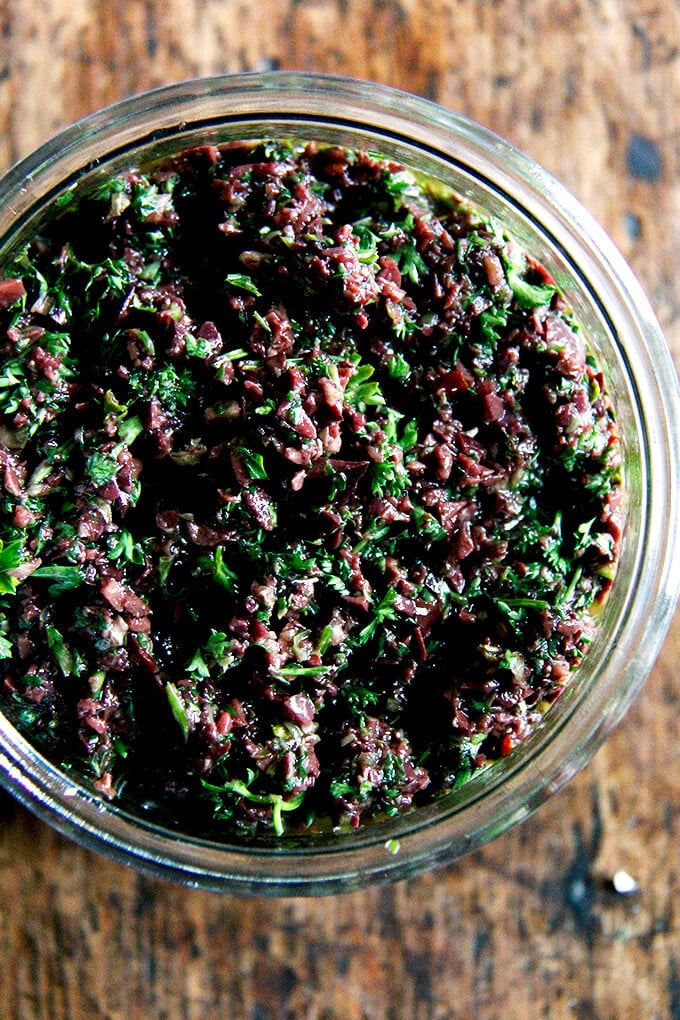
I made this black olive tapenade to serve as an appetizer for a smaller gathering earlier this year, and I’ve since made it for a number of occasions since because it’s so darn easy and good. The food processor does 95% of the work: after 30 or so quick pulses, the recipe is nearly complete.
But the key, I think, to making a really good tapenade, lies in the care you take while completing the last 5% of the job: chopping a heap of parsley by hand.
Why is this important? If you rely on the food processor to chop all of the parsley, your finished tapenade will still taste delicious, but it will lack variety in color, and I find those pops of green punctuating the dark purée to be so visually appealing and, in turn, appetizing.
Stirring in the olive oil by hand, moreover, as opposed to while the food processor blade is whirring, also prevents the texture from turning to mush. In sum, to make great olive tapenade every time:
- Pulse. Don’t purée.
- Chop half of the parsley by hand and stir it into the tapenade by hand.
- Don’t add the olive oil to the food processor. Stir it in by hand.
What to serve with olive tapenade?
Serve this tapenade with bread, of course, for a simple appetizer. It’s also nice with lamb.
Recently, I’ve been making slab sandwiches with the overnight focaccia, this tapenade, roasted red peppers, greens, and whipped honey goat cheese.
Or, you can serve it as part of an array of dips and spreads:
More Dips and Spreads
- Homemade “Ranch” Dip (made with Greek yogurt, a huge crowd pleaser!)
- Raw Beet Dip with Toasted Almonds (The hue of this dip is striking!)
- Smoky Eggplant Dip with Za’atar (Serve this with homemade pita!)
- Tzatziki (I could eat this with anything.)
- Spicy Cashew Dip (addictive!)
Can green olives be used in place of black olives?
Yes, absolutely! I typically use Kalamata olives here, but you can absolutely use green olives, such as Castelvetrano, in their place. Buy pitted olives to save yourself the trouble of having to pit the olives.
How do you store olive tapenade? And for how long?
Store olive tapenade in the refrigerator for 1 week. Bring to room temperature before serving. If the parsley looks dull after the tapenade has spent a few days in the fridge, spruce it up by adding freshly chopped parsley.
Here’s the play-by-play: Gather your ingredients:
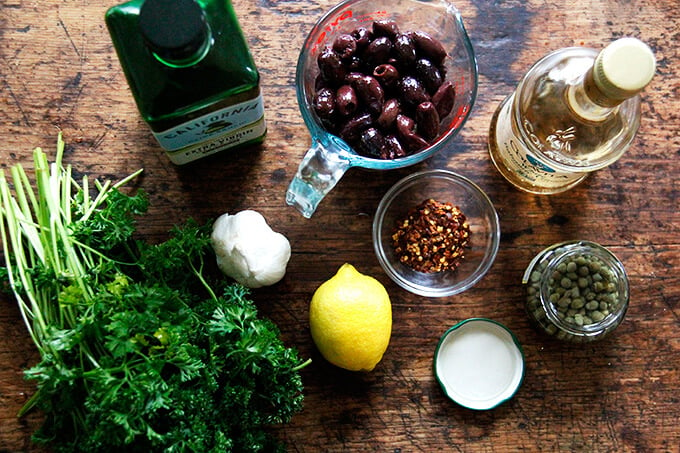
Place everything into the food processor with the exception of half of the parsley and the olive oil.
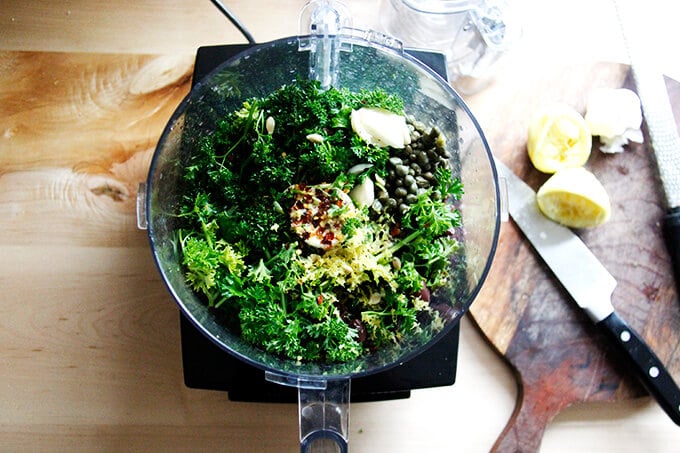
Pulse until finely chopped but don’t let it turn to mush.

Transfer to a bowl. Chop the remaining parsley by hand.
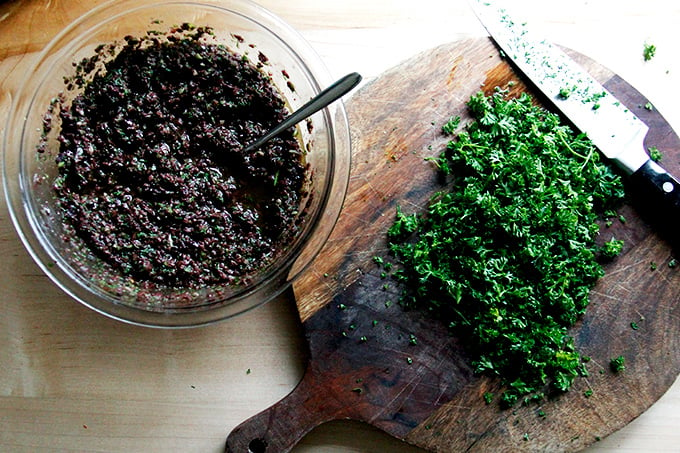
Add the parsley and the olive oil, and stir to combine.

Serve or transfer to the fridge. Store for up to 1 week. Bring to room temperature before serving.
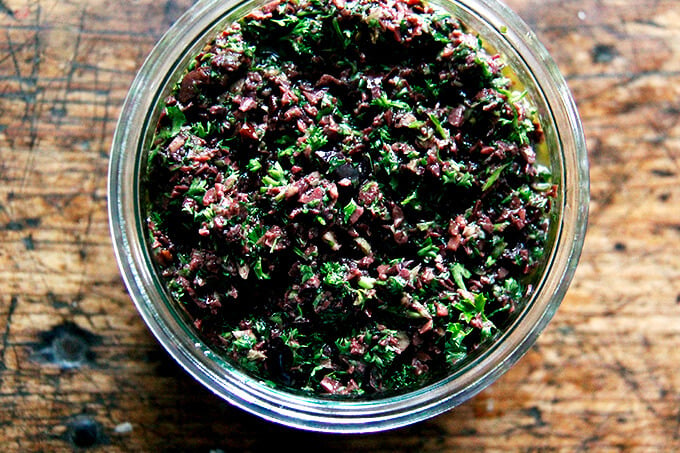
Slab sandwich: Roasted Red Peppers, whipped honey goat cheese, tapenade and greens:


Olive Tapenade with Capers & Parsley
- Total Time: 15 minutes
- Yield: 2 cups
Description
A favorite spread to put out for guests, to smear over sandwich bread, and to eat straight up with a spoon, this tapenade is loaded with parsley, lemon and olive oil. You can tailor the heat to your liking by increasing or decreasing the pepper flakes as you please.
Olives: I typically use Kalamata olives here, but you can absolutely use green olives, such as Castelvetrano, in their place.
Roasted red peppers pair nicely with this tapenade as does whipped honey goat cheese. Serve with toasty bread or make a sandwich. Irresistible.
Ingredients
- 2 cups pitted black olives, such as Kalamata, see notes above
- grated zest and juice of ½ to 1 lemon
- pinch crushed red pepper flakes, optional
- 2 cloves garlic, peeled
- 2 tablespoons capers, drained
- 1 tablespoon white balsamic vinegar
- 2 cups (about) parsley, divided roughly into two 1-cup portions
- 1/3 cup olive oil, plus more to taste
Instructions
- Pulse the olives, zest, juice of half a lemon, pepper flakes, garlic, capers, vinegar, and half of the parsley in the food processor until a coarse paste is formed—be sure to pulse to avoid turning the purée into complete mush. It may take 20 to 30 quick pulses.
- Transfer the mixture to a bowl. Finely chop the remaining parsley, and stir it in. Stir in the olive oil. Taste; then adjust seasoning as necessary with more lemon, pepper flakes, or olive oil. I almost always end up using the remaining half lemon, and I always stir in more olive oil by the tablespoon until the mixture both looks and tastes right.
- Store olive tapenade in the refrigerator for 1 week. Bring to room temperature before serving. If the parsley looks dull after the tapenade has spent a few days in the fridge, spruce it up by adding freshly chopped parsley.
- Prep Time: 15 minutes
- Category: Condiment
- Method: Food Processor
- Cuisine: Greek
This post may contain affiliate links. Please read my disclosure policy.






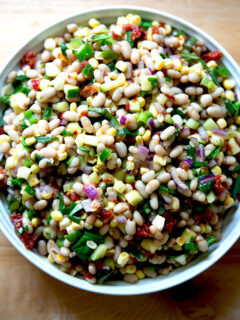





23 Comments on “Olive Tapenade with Capers & Parsley”
Ooooohhh this looks so good! I hated olives as a kid, but I am slowly slowly coming around to them! This might be the next thing to make in my quest to like them! hahaha.
xx
ERIN!! So fun to see you here!! My kids don’t touch olives… you’re normal 🙂 🙂 🙂
That looks very delicious!
🙂 🙂 🙂
wonderful! great tip too about chopping the parsley by hand to preserve the color, I even have a mini processor for small batches of one, thank you for this tapenade
Knew I had to make this today. This tapenade is wonderful! I used half Greek and half Mediterranean olives and Meyer lemon. My white balsamic is at least a couple of years old. Nevertheless my neighbors and I are loving this very easy-to-make treat as we cool down from a warm98 degree day. Love it! Thanks
Question…you said you took this to gatherings. What did you serve it with? Bread? Anything else?
Great on her focaccia. Made and served it today with the focaccia–wonderful. And I thought I did not like olives–I love this!
Yay! So happy to hear this, Gay 🙂 🙂 🙂
Any other herb that you would recommend? Allergic to parsley…
Such a great party hors d’oeuvre–I’ve made it three times now, served with your overnight refrigerator focaccia, and it’s been such a success. I prepared the olives the day before but chopped the parsley just before serving to preserve its brightness.
Made this today for the slab sandwich and it was so fresh! Not as salty as the kind you find at an olive bar, which is great because I controlled that part of it 🙂 Can’t wait to eat with all the food!
Yay!! So happy to hear this, May!
Can this be made ahead and frozen?
I’ve never tried, so I can’t say for sure. A google search is telling me yes, but I hesitate to give you the green light without personally trying.
This recipe looks so, so good! Your video explanation is great – breaking down the details and why. And I loved listening to your kids or husband playing the piano in the background. Thank you Ali for this video tip. I will make this.
Awww thanks, Pey-Lih 🙂 🙂 🙂 Means a lot 💕
I had a large bag of sliced olives given to me a few years ago. I finally thawed them out and chose to make this recipe for a community pot luck. Despite the age of the main ingredient, this tapenade was applauded for flavour. I didn’t have enough of any one type of greens for the double recipe and used chives, cilantro, celery leaf, and thinly sliced romaine lettuce. The parsley was not missed. Yum yum!
Great to hear, Cher! Thanks so much for writing and sharing all of your notes. I love how forgiving/adaptable this recipe is.
Hi chef,
This looks awesome and I’m going to try it tonight with your overnight focaccia recipe and slab sandwich 😋
Just one question, there isn’t any salt in the recipe. Is that right? Or that’s too obvious to mention? 🤓
Cheers
Hi! Olives and capers are super salty, so you don’t need additional salt in this one.
So quick and easy to make! I love olives, and salt, and I’ve never tried making tapenade before. Sounds like it is quite easy to put together.
Very nice recipe chef 👍👌👏. Thank you for your effort 🌞😎